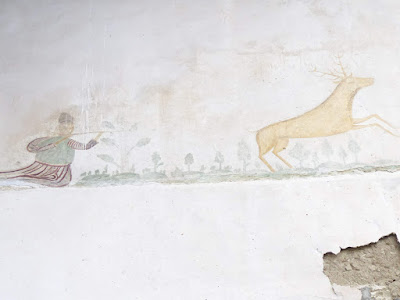
We had a very busy day ahead of us and although it had stopped raining, it was still too cloudy to take advantage of the view from my lovely hotel room.

Anyway, our first visit this morning was through the old communist industrial area of the town where some of the factories are still being used by co-operatives.
 Our guide told us this was a pasta making factory and is still in use. being so close to Italy, pasta featured on many menus.
Our guide told us this was a pasta making factory and is still in use. being so close to Italy, pasta featured on many menus.

We visited a jam making industry. They only use local produce that is in season, which is all you will get in the restaurants as they do not import fruit and veg from around the world unlike we do in the UK. Hence the food is so fresh and delicious here. They were in between seasons at the factory. All the soft fruits had finished and they were now awaiting the oranges as their next main crop.

There were vats of figs and walnuts which were being softened, soon to be turned into jams.
We tasted fig, walnut, cherry, watermelon, quince and even grape jams. All of which were delicious.
Afterwards a couple of us walked to the city stone by the river and climbed to the top for a view of the town. The city stone is 25m tall and 15m wide and 30m in diameter. It is thought it was part of a fortress in the Middle Ages. There are stairs leading up to the summit.
I enjoyed viewing the town from this height. This is the Albanian flag flying from the top.
We left Permet and were driven to the area of Dhokset to visit a family and have lunch with them. We drove off the main road and travelled some distance through the countryside along narrow bumpy lanes. It gave us a chance to see more of the life in these very small villages which are all over this very mountainous country. The fields mainly contained small flocks of sheep always accompanied by a shepherd. Farming is never on a large scale. During the communist era people were given just a small strip of land to farm and this seems to have continued after independence with people growing food for their own needs or small cooperatives. I never once saw large fields of crops or any large farm machinery. Farming was mainly being done in the traditional way with hand tools.
The house we arrived at for lunch was huge. The owners had added to it over the years and generations that they had lived here. It was an unexpected surprise in this small village. The meal was incredible. It was vegetarian with courgette rissoles, stuffed peppers, mushrooms. salads, cheese, beetroot and many more dishes. They had grown and prepared all the food themselves including the cheese.
 Afterwards we strolled around the village.
Afterwards we strolled around the village.
Not sure what this building was used for but it is a large building for a small village. It looks communist in style so perhaps was a factory of some description.
Every garden was full of fruit and veg.
A plaque to Lord Byron, the English poet, who had visited the village whilst on a tour of the Mediterranean in 1809.
Pomegranates were everywhere and I picked one off a tree which I later peeled and ate. It was so juicy and sweet.
From there we went to the town of Gjirokastra where we were spending the night. After dropping off our luggage we walked to the top of the hill for a tour of the castle. It was an impressive castle with great views of the town.
The clock tower was built under the rule of Ali Pasha in the early 19th century. According to legend, its bell could be heard as far away as Ioannina in northern Greece. However it was the next place we visited that was the most interesting.
This was Skenduli, a 17th century house in the middle of the town. Originally the family home of someone of wealth. I was surprised by the number of rooms. A basement provided shelter during earthquakes right up to a small room on the third floor where human waste would go down a pipe to a primitive sewage system. Also at the top of the house was a room for just the men with a gallery for the women so that they couldn't be seen.
Original wall paintings could still be seen both inside and outside the building. (Photos were not allowed of the inside.)
We just about managed to see it all before darknesss fell. After such a huge lunch we didn't want dinner but picked up a small pastry type of cheese sandwich in the bazaar. We wandered around and found our way to a hotel near the top of the hill where we could look down on the lights of the town and enjoyed a very nice gin and tonic.
 A conveniently placed hotel at the bottom of the hill made an ideal spot for a tea break before moving on to Apollonia.
A conveniently placed hotel at the bottom of the hill made an ideal spot for a tea break before moving on to Apollonia.








.jpg)




















.jpg)
.jpg)




































